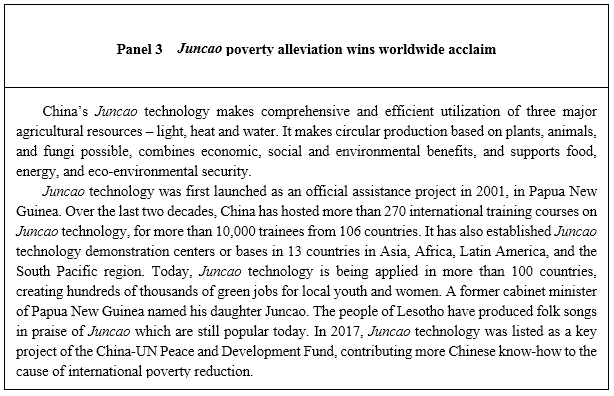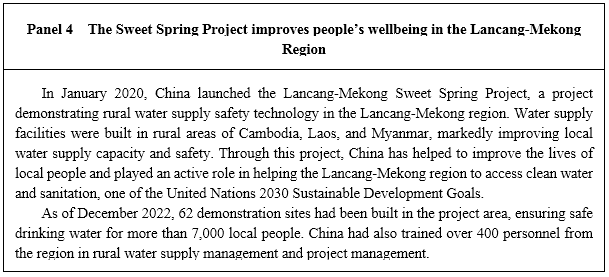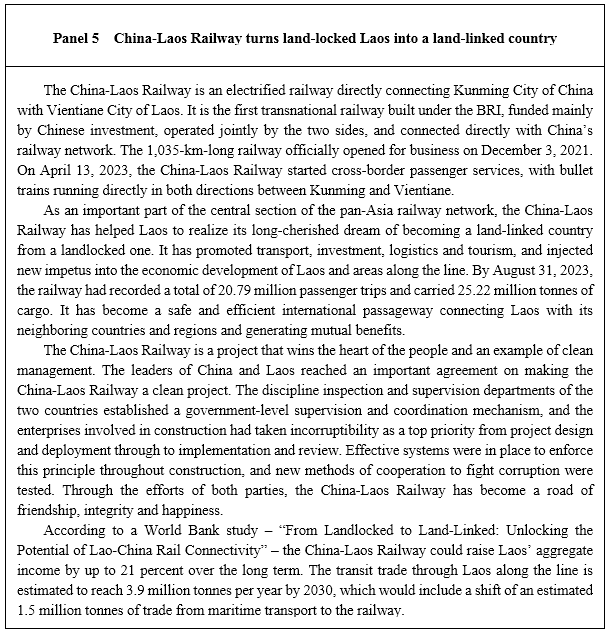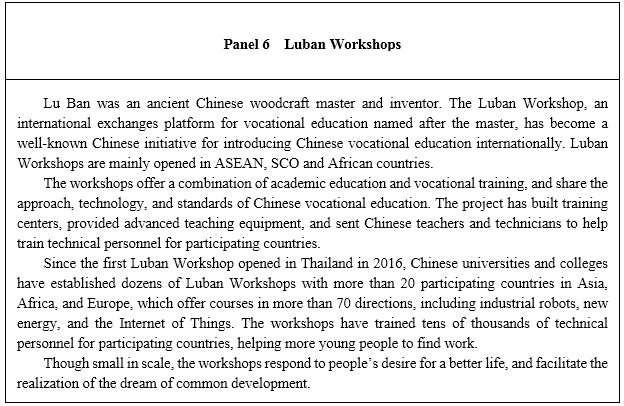Full text: The Belt and Road Initiative: A Key Pillar of the Global Community of Shared Future
Xinhua | October 10, 2023
IV. Injecting Positive Energy into World Peace and Development
Over the past decade, BRI cooperation has witnessed remarkable results. It has opened up new space for world economic growth, built a new platform for international trade and investment, reinforced the development capacity of relevant countries and improved people's lives, sought ways to improve the global governance system, and brought greater certainty and stability to a world fraught with turbulence and change. The BRI has boosted China's development and benefited the rest of the world.
1. Bringing tangible benefits to participating countries
Development is an eternal theme for humanity. The BRI has focused on the fundamental issue of development, addressing the weaker links and bottlenecks that hinder development, building new engines for economic development, and creating a new development environment and space for participating countries. This has strengthened their confidence and their capacity for development, and improved their people's lives. The initiative has contributed to addressing global development imbalance and advancing modernization in all countries.
Boosting development in participating countries. Over the last 10 years, the BRI has addressed the major bottlenecks restricting connectivity and economic growth in most of the developing countries. A large number of infrastructure projects have been built, with significant progress for participating countries in the construction of railways, highways, pipelines, shipping, energy, communications and other basic public service facilities. This has improved local living and working conditions and the development environment, and boosted their capacity for independent economic development.
Some engineering projects with a long construction cycle are like seeds sown in a field, gradually generating comprehensive benefits for the long term. Connectivity in infrastructure has effectively reduced the cost for countries to participate in international trade, increased their access to the global economy, and stimulated the potential and impetus for their development. Research by the Asian Development Bank shows that lowering a land-locked country's trade costs by 10 percent through improvement in infrastructure could increase its exports by 20 percent.
Industrial capacity cooperation has promoted industrialization, digitization, informatization, and the structural upgrading of industries in participating countries. It has helped them to form competitive industrial systems and expand the breadth and depth of their participation in the international division of labor and cooperation, creating more opportunities and greater space for development.
China has actively conducted international cooperation in emergency management. It has sent rescue teams to Nepal, Mozambique, Türkiye and other countries to carry out humanitarian operations following earthquakes and floods, and provided emergency supplies and technical support to Tonga and Madagascar, among other countries.
Building poverty reduction capacity in participating countries. Developing countries still face the challenge of problems related to food. China has taken an active part in global food and agriculture governance. It has released the Vision and Action on Jointly Promoting Agricultural Cooperation Along the Belt and Road with partner countries, and signed more than 100 agricultural and fishery cooperation documents with almost 90 partner countries and international organizations. Its trade in agricultural products with BRI partners has reached US$139.4 billion. China has sent more than 2,000 agricultural experts and technicians to over 70 countries and regions, and introduced more than 1,500 agricultural technologies such as Juncao and hybrid rice to many of these countries. It has helped with rural poverty reduction in Asia, Africa, the South Pacific, Latin America, and the Caribbean, developing modern agriculture and helping to increase farmers' incomes.
Boosting employment is an important element of poverty reduction. In the process of BRI cooperation, China has helped to construct industrial parks with participating countries and provided guidance for Chinese enterprises to create jobs for local residents through high-level industrial cooperation. The jobs provided to locals have helped to lift their families out of poverty. A McKinsey survey revealed that Chinese firms in Africa recruited 89 percent of their employees locally, contributing to local employment in an effective way.
The World Bank has estimated that by 2030, BRI-related investments could lift 7.6 million out of extreme poverty and 32 million out of moderate poverty.

Delivering notable results in projects that improve people's lives. Chinese firms have repaired and maintained bridges to make it easier for local residents to travel. They have drilled wells to meet local villagers' needs for drinking water. They have installed street lamps for pedestrians to see clearly on their way home at night. Many such seemingly small projects have solved urgent problems for local people and improved their daily lives. They have brought tangible benefits to the people of participating countries, and increased their sense of gain, fulfillment and security.
Over the last 10 years, Chinese firms have launched more than 300 poverty alleviation, health care and rehabilitation, and Happy Home projects in participating countries. They have helped with the construction of the headquarters of Africa Centres for Disease Control and Prevention and the China-Pakistan Fraternity Emergency Care Center in Gwadar, Pakistan. They have also helped Cameroon, Ethiopia, Djibouti and other countries to provide clean drinking water for the local people.

The Silk Road Community Building Initiative has promoted projects in more than 20 areas, including poverty alleviation and disaster relief, humanitarian assistance, environmental protection, and women's exchanges and cooperation. Related activities have had an extensive impact.
2. Adding vitality to economic globalization
Against a rising tide of de-globalization, the BRI is committed to global connectivity and interconnected development. It has further opened up the main arteries of economic globalization, facilitated the flow of information, capital, technology, product, industry and people, and promoted closer and broader international cooperation. By expanding economic globalization and distributing its benefits fairly, the BRI aims to promote global development that is balanced, coordinated, inclusive and shared by all, and that brings win-win cooperation and common prosperity.
Boosting the momentum for global development. The BRI has connected the vibrant East Asia economic circle at one end, the developed European economic circle at the other, and the countries in between with huge potential for economic development, and fostered closer economic cooperation with African and Latin American countries. It has formed a new global development dynamic in which the Eurasian continent is fully connected with the Pacific, Indian and Atlantic oceans, and the land is integrated with the sea. It has expanded the scope and coverage of the international division of labor in a broader economic and geographical space, and enlarged the global market, which ultimately promoted new global economic growth.
At the same time, through infrastructure connectivity, the BRI has proved a catalyst to international investment and boosted global interest in and enthusiasm for investment in infrastructure, which provides economic growth and rapid development in participating countries. These efforts have effectively addressed the shortage of international public goods and provided sustained impetus for world economic growth.
Encouraging deeper regional economic cooperation. In strengthening infrastructure connectivity, the BRI promotes connectivity between countries in many directions and various fields. The BRI turns dots into lines and lines into fields, gradually amplifying the radiation effect of development. It encourages countries to coordinate economic policies, systems and mechanisms, and innovate cooperation models, conduct broader, deeper and closer regional cooperation, and jointly create an open, inclusive and balanced regional economic cooperation architecture that benefits all. It has facilitated a freer and more orderly flow of economic factors, more efficient allocation of resources, and deeper integration of markets, and upgraded economic and trade connectivity and vitality between countries and regions, and the overall position of participating countries in global industry chains, supply chains, and value chains.
Participating countries have made full use of their own factor endowments to integrate, coordinate, and upgrade their industry chains, promote industrial complementarity, and improve the efficiency of division of labor. They have broken down trade barriers and market monopolies, unleashed internal and cross-border consumption potential, and expanded the scale of regional markets. Through technology transfer and cooperation in industrial cooperation, they have established technology interaction and interdependence, strengthened capacity for innovation, and promoted leapfrog development.
Promoting global trade. The BRI supports the liberalization and facilitation of trade and investment by building transport and information infrastructure in a planned and progressive manner. It has eliminated internal, transnational, and inter-regional transport bottlenecks and barriers to trade and investment cooperation, made cross-border logistics and foreign trade easier and more convenient, and increased the efficiency of domestic and international cooperation. It has built up an all-round, multi-level and complex network of unimpeded trade, creating a new dynamic and greatly facilitating global trade.
At the same time, the BRI has made participating countries more attractive to quality global capital, and contributed to rising direct cross-border investment in these countries. In 2022, cross-border direct investment inflows in Southeast Asia accounted for 17.2 percent of the global total, 9 percentage points higher than in 2013. The inflow of FDI into Kazakhstan grew by a historical high of 83 percent year on year.
World Bank study - "Belt and Road Economics: Opportunities and Risks of Transport Corridors" - estimates that prior to the BRI, the six corridor economies undertrade with each other and the rest of the world by 30 percent on average and they fall short of their absorptive potential of FDI by 70 percent. Transport infrastructure projects under the BRI would reduce trade costs for the world by 1.8 percent, and reduce trade costs along the China-Central Asia-West Asia economic corridor by 10 percent. This has greatly facilitated global trade and boosted economic growth. The study projects that trade growth would range between 2.8 and 9.7 percent for corridor economies and between 1.7 and 6.2 percent worldwide, and global real income is expected to increase by 0.7 to 2.9 percent.
Maintaining the stability of global supply chains. An efficient and interconnected international transport corridor established under the BRI framework plays an important role in maintaining the stability and smooth flow of global supply chains.
During the Covid-19 outbreak, ports and logistics companies canceled or reduced services for shipping and freight transport, which had dealt a hard blow to those global supply chains which were highly dependent on shipping.

As a key output of BRI cooperation, the China-Europe Railway Express effectively sustained rail connectivity on the Eurasian continent, boosted sea-rail, road-rail, air-rail, and other forms of multi-modal transport, and opened up a new transport corridor for the Eurasian continental supply chain. Together with the innovations in customs clearance such as the Customs-Train Operators Partnership for Secure and Expedited Clearance of CR Express Carried Goods (C-TOP), Rapid Customs Clearance for rail service, China made an important contribution to stabilizing the global economy.
Several well-known international logistics associations have stated publicly that the China-Europe Railway Express has provided the world with a reliable logistics solution that can effectively alleviate tensions in the global supply chain and strengthen international logistics.
3. Providing new solutions for improving global governance
The deficit in global governance presents a severe challenge to the whole world. The BRI supports genuine multilateralism, and cherishes shared growth through consultation and collaboration in global governance. It advocates dialogue rather than confrontation, removing walls rather than erecting walls, integration rather than decoupling, and inclusiveness rather than exclusion. This is a new paradigm for state-to-state relations that shapes the international order towards greater justice and equality.
Gaining more recognition for the concept of global governance. The BRI's core principles of "extensive consultation, joint contribution, and shared benefits" have appeared in important documents from international organizations and mechanisms, including the UN and the Forum on China-Africa Cooperation.
The vision of a global community of shared future has developed deep roots. A number of bilateral communities have been built between China and other countries, including Laos and Pakistan. Steady progress has been made in building multilateral communities, including those between China and Africa, the Arab States, Latin America, ASEAN, Central Asia and Pacific Island countries. Practical results have been achieved in building communities in functional areas, including cyber space, maritime cooperation, and health for all.
According to the China's National Image Global Survey released by the Academy of Contemporary China and World Studies in 2020, the BRI is the Chinese proposal with the highest level of acceptance overseas, with more than 70 percent of respondents recognizing the positive impact of the BRI on individuals, states and global governance. European think tank Bruegel released a paper titled "Global Trends in Countries' Perceptions of the Belt and Road Initiative" in April 2023, which noted that the BRI is generally positively received in the world, and Central Asia and sub-Saharan Africa, in particular, exhibit strongly positive sentiment towards the BRI.
Improving multilateral governance mechanisms. The BRI upholds the principles of mutual respect and equality, openness, inclusiveness, and win-win results. It enshrines multilateralism by securing international fairness and justice, and protecting the rights and interests of developing countries.
The BRI helps improve the existing multilateral governance mechanisms by firmly upholding the authority and status of the UN, and striving to consolidate and strengthen the stature and effectiveness of global multilateral governance platforms such as the WTO. It actively promotes new multilateral governance mechanisms such as the Asian Infrastructure Investment Bank, and works with participating parties to promote governance mechanisms in emerging areas such as the deep sea, polar regions, outer space, internet and artificial intelligence.
The BRI has strengthened the position and role of developing countries and emerging economies in the world market system, and increased their discourse power in regional and global economic governance. As a result, the aspirations and concerns of developing countries are increasingly included in the global agenda - a significant improvement in global governance.
Innovating and optimizing global governance rules. Taking into account the differences in the level of economic development, factor endowments, and cultural and religious traditions of relevant parties, the BRI has not preset any rules and standards, nor does it draw ideological lines. Instead, it formulates new rules to solve new problems through full consultation and in-depth exchanges, based on the wishes and needs of the parties involved.
BRI participating countries seek synergy in their strategies, plans, mechanisms, projects, and rules and standards, which helps to optimize the rules for BRI cooperation, and supports the transition from opening up based on the flow of goods and factors of production to opening up based on rules and related institutions. Some rules and standards with strong potential for universal application have been formulated in this process, which has effectively filled in gaps in the global governance system in these areas.
4. Garnering strength for the progress of human civilization
Exchanges and mutual learning among civilizations drive human progress and global peace and development. In contrast to those who persist with black and white thinking, concoct such concepts as the "clash of civilizations" and "superiority of Western civilization", and provoke large-scale ideological confrontation, the BRI advocates equality, mutual learning, dialogue, and inclusiveness among civilizations, and promotes the shared values of humanity. It has charted a path of exchanges and mutual learning among civilizations for all to prosper individually and?collectively, in order to achieve closer ties among peoples and link up the cultures and hearts of all countries.
Improving the mechanisms for people-to-people exchanges. People-to-people exchanges cover a wide range of areas, including politics, culture, the arts, sports, and education. The global influence of various multilateral and bilateral political party exchange mechanisms has increased with the creation of mechanisms such as the CPC and World Political Parties Summit, and the CPC in Dialogue with World Political Parties High-level Meeting. The leading role of high-level inter-party exchanges garners consensus and strengths for stronger people-to-people ties.
Various BRI cooperation mechanisms have emerged, including the Silk Road Think Tank Association, the Belt and Road Initiative Tax Administration Cooperation Mechanism, the ANSO, the Belt and Road Health Professionals Development Alliance, the Silk Road International League of Theaters, and the Silk Road International Museum Alliance. The emergence of such mechanisms has facilitated people-to-people exchanges in diverse forms, promoting mutual understanding, mutual respect, and mutual appreciation among the peoples of all countries.
China, Kyrgyzstan, Iran and other Central and West Asian countries jointly launched the Alliance for Cultural Heritage in Asia - the first international cooperation mechanism regarding Asian cultural heritage - to protect cultural heritage, the tangible carriers of civilization. The projects under the framework of the alliance, for example the protection and restoration of Uzbekistan's ancient city of Khiva, have been highly commended by UNESCO.
Creating quality brand projects and activities. Several projects and activities have become popular and attracted widespread public participation. Examples include the Silk Road (Dunhuang) International Cultural Expo, the Belt and Road/Great Wall International Folk Culture and Arts Festival, the Silk Road International Arts Festival, the Maritime Silk Road International Arts Festival, the Belt and Road Youth Story, and the Tea Road Cultural Tourism Expo.
Cultural and people-to-people exchange programs have won wide acclaim, including the Silk Road Community Building Initiative, the Kit of Love of medical supplies, Luban Workshops of technical vocational training, the Happy Spring well-drilling project, the Brightness Journey program of free cataract surgeries, the Panda Pack Project of school supplies, the Amity Torch Program of educational assistance, the Belt and Road Tour of Acupuncture-Moxibustion promoting traditional Chinese medicine therapies, and the Confucius Classroom of cultural exchanges.
As these goodwill activities, quality brands, and signature projects continue to emerge, they have become an important means through which all parties can join to strengthen people-to-people ties. This reinforces the sense of identity and belonging of the peoples of all BRI participating countries.
Galvanizing the power of youth. The future of the BRI belongs to the youth. Over the last 10 years, young people in participating countries have engaged proactively in people-to-people exchanges and programs that create a better life. The younger generation has galvanized the tremendous power of youth for strengthening people-to-people bonds and realizing common development.

The Chinese Youth Global Partnership has received a positive response from all over the world. More than 100 national youth organizations and international organizations have established ties and cooperative relations with China.
Sixteen events of the Belt and Road Youth Story have attracted more than 1,500 young people from participating countries. Focusing on poverty alleviation and reduction, climate change, and pandemic response cooperation, participants shared with the audience their stories and experience in promoting social development and their own development, which vividly demonstrated the right way to view the world from the perspective of appreciation, mutual learning, and sharing.
Other successful activities have also taken place, including the Silk Road Incubator Youth Entrepreneurship Program and the China-Central and Eastern Europe International Forum for Young Innovators, which have become important platforms for the youth of participating countries to strengthen friendly exchanges and cooperation.

